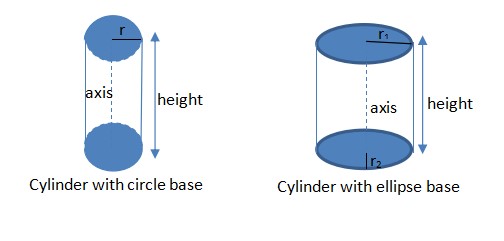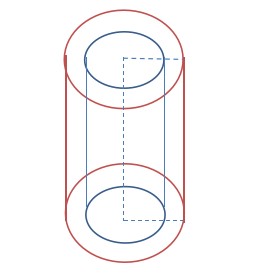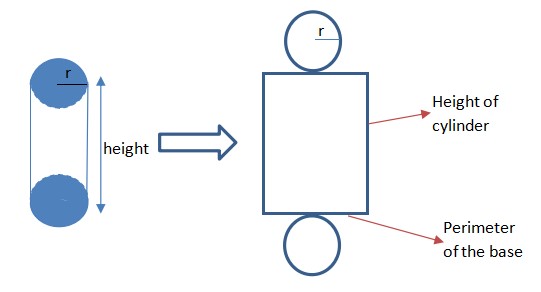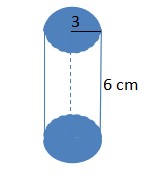“cylinder” was named base on Latin (Cylindrus) and Greek (Kylindros). It means “roll”, “roller”, and “tumblr”. Cylinder is a shape that is common in daily life such as can, money box, toilet tissue roll, tumbler, etc.
Table of Contents
Definition of Cylinder
Cylinder is three-dimensional shape with two congruent parallel circular shape (circles or ellipse). There is also a curved side. The parts are radius in the circle (as the bottom and upside) and height as distance between the circles.
It has axis as the distance between center of the basses. The side of cylinder is a rectangle with perimeter of the base as the width and the height of cylinder as the length.

Properties of Cylinder
There are properties of cylinder.
- The bases (flat faces) are always parallel and congruent
- It has two curved edges.
- It has one curved face.
- it has no vertex (specific corner).
- Distance between center of the both bases called axis.
- Surface area of cylinder is sum of the bases and the side.
- Volume of cylinder is space inside the cylinder.
Type of Cylinder
There are some types of cylinder:
- Right Cylinder
Right cylinder is a type of cylinder that has axis perpendicular to center of the base.
- Oblique Cylinder
Oblique cylinder is a type of cylinder that has axis that is not perpendicular to the center of the base. The real example is Pisa tower.
- Elliptic Cylinder
It is cylinder that has ellipse in the bases.
- Circular cylinder
Circular cylinder has circle as the bases.
- A right circular hollow cylinder
It is also known as cylinder shell. The cylinder has a hole inside. There are two right circular cylinder that are different in radius but they merge so that the axis has same points.

Surface Area of Cylinder
Surface area of a cylinder is all of surface that cover the cylinder. It consists of two circular shape and the side. The side is rectangle with perimeter of the base as the width and the length of cylinder as the length. It is called as curved surface area of cylinder.

Curved surface area = length x width
= perimeter of the base x height
= 2pr x h
Surface area of cylinder = curved surface area + bases area
= 2prh + 2 (pr2)
= 2pr(h+r)
Volume of Cylinder
Volume of cylinder means space inside the cylinder. In another words, it is space that is bordered by the cylinder.
Volume of cylinder = base area x height
= 2pr2 x h
Examples
- Determine volume and surface area

- Volume = 2pr2 x h
= 2p(3)2 x 6
= 108p cm3
- Surface area = 2pr(h+r)
= 2p(3)(6+3)
= 54p cm2
2. Determine radius of the base if the cylinder has height 12 cm and the volume is 192p cm3.
Volume = 2pr2 x h
192p = 2pr2 x 12
r2 = 8
r = 2√2cm
3. Determine curved surface area if the surface area is 225p cm2 and the r = 4 cm.
Surface area of cylinder = curved surface area + bases area
225p = curved surface area + 2(pr2)
225p = curved surface area + 2(p(4)2)
225p = curved surface area + 32p
curved surface area = 225p – 32p
= 193p
